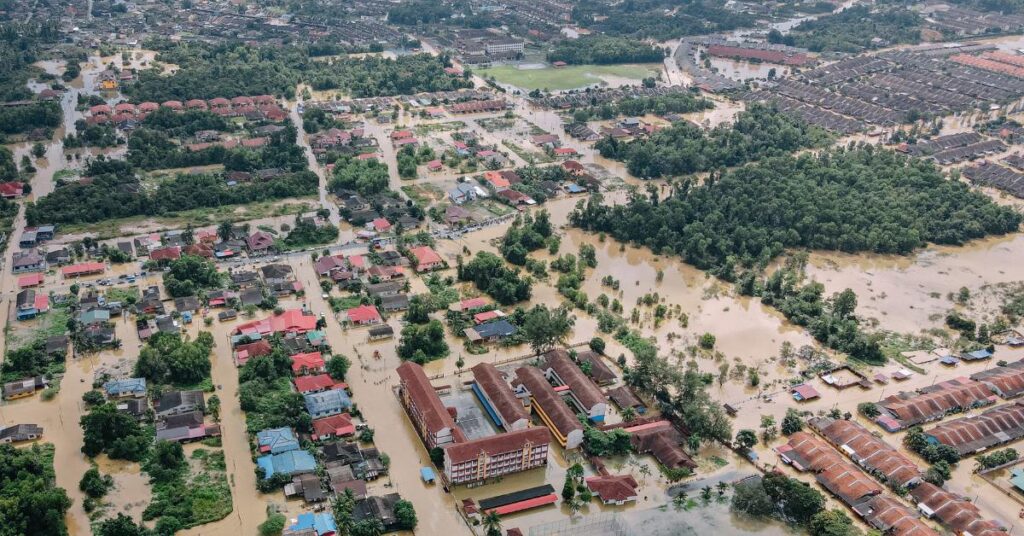Texas Flood Control Solutions
Choosing the right Texas flood control solutions is essential for protecting your community. TrapBag is a flexible, affordable, and effective solution.

After the major flooding events that Texas has experienced over the last several years, many communities are looking for ways to better protect their homes, their businesses, and their citizens.
The state plans to invest billions of dollars over the next few years to build better flood protection services in Texas. It’s vital for Texan communities to choose affordable and effective solutions for hurricane barriers, stormwater containment, and erosion prevention.
When Does Flooding Occur in Texas?
The season of heightened flood risk begins in late spring and early summer, as snowmelt from higher elevations causes rivers to rise and the first major thunderstorms of the year begin. The most rainfall ever recorded in a single month in Texas was in May 2015 when 17.59 inches fell on Austin.
Hurricane season runs from June 1 to Nov. 1, and it brings some of the biggest flooding, particularly from August to October. Not only do Texans need to worry about heavy rainfall and high winds during hurricanes, but storm surges are also a significant issue—especially when four coastal counties are just 7 feet above sea level.
A History of Flooding in Texas
Unfortunately, Texas has a long history of hurricanes and heavy rainstorms that have caused flooding throughout the state. The state is particularly vulnerable to flooding because of its flat terrain of sand and clay with minimal vegetation. The land is unable to quickly absorb heavy rainfall, which can lead to overflowing rivers and flooding.
Galveston suffered the deadliest hurricane in US history in 1900 when approximately 8,000 people died due to 145 mph winds and a 15-foot storm surge. When Hurricane Ike hit the state in Sept. 2008, it caused storm surges that exceeded 17 feet, and Hurricane Carla caused 22-foot storm surges that made it up to 10 miles inland.
One of the most recent major hurricanes to strike Texas was Hurricane Harvey in August 2017. The Category 4 hurricane was particularly devastating because it stayed over Texas for several days after making landfall, dropping more than 48 inches of rain in some parts of the state. Harris County was estimated to have received more than a trillion gallons of water in just four days
How Climate Change Affects Texas Flooding
Unfortunately, the risk of flooding in Texas is only expected to grow due to climate change. As temperatures warm, more water will be evaporated and the additional water vapor in the atmosphere will create larger rain clouds. This will increase the strength of hurricanes and lead to heavier rainfall during storms. Around one-fifth of Texas is currently in a 100-year flood plain, meaning there is a 1% chance of flooding every year.
What Are the Best Flood Barriers in Texas?
TrapBags are an effective solution for Texas flood control because they are affordable, quick to deploy, and reliable. They allow you to build a Texas hurricane barrier from a series of pentagon-shaped bags made with high-strength textile.
TrapBags can be filled with sand or crushed gravel using a simple process that allows them to be deployed much faster than traditional methods. A small team using a front-end loader or skid steer can deploy an effective TrapBag barrier within a matter of hours with minimal training. Once filled, the bags interlock to create a sturdy and water-resistant barrier that can be used to divert floodwaters, protect infrastructure, and mitigate soil erosion.
Where Have TrapBags Been Deployed?
TrapBags have been successfully deployed to prevent flooding and erosion both before and after major hurricanes in Florida, New York, and other states. They have protected homes and businesses along the shoreline of Lake Michigan during heavy erosion due to high water levels. TrapBags have also been used as protection against mudslides and to build or stabilize coastal sand dunes.
Using TrapBag as Texas Flood Control
Stormwater Containment
If you’re looking for effective flood control in Houston, Dallas, or another city, TrapBags can create the perfect barrier against floodwaters. By creating a permanent containment pool or temporary detention basin, you can redirect the flow of water and prevent it from overflowing and disrupting your homes, businesses, and infrastructure.
Erosion Control
Recent estimates have found that 64% of the Texas coastline is eroding at a rate of six feet each year, though some shorelines have lost more than 30 feet each year. It can have a significant impact on property values, tourism, shipping, fishing, and other parts of the local economy. It also cuts down on the land’s natural ability to protect against flooding from hurricanes and storm surges.
TrapBags can be used to fight against erosion both before and after a major storm by protecting beaches and stabilizing dunes. They can be used as temporary measures until permanent solutions are built or repaired, or they can serve as permanent solutions in their own right.
Levees
Levees are an important part of preventing Texas rivers and other bodies of water from overflowing during heavy rainfall. While natural levees will be enough to prevent flooding for most storms, it’s always a good idea to give them a boost when you know that a significant storm is on its way. Fortunately, TrapBags can be deployed quickly to create give your levees an extra few feet of protection—just in case you need it.
Get a Free Quote on TrapBag
Interested in using TrapBags for your Texas flood control solution? Reach out to the team to learn more about building a flood barrier for your community.
Meet the author
Get the Dirt Before the Flood Hits
Stay ahead of flooding, erosion, and disaster response challenges. The Dirt, TrapBag’s monthly newsletter, delivers field-tested tips, real-world case studies, and the latest in barrier technology straight to your inbox.

